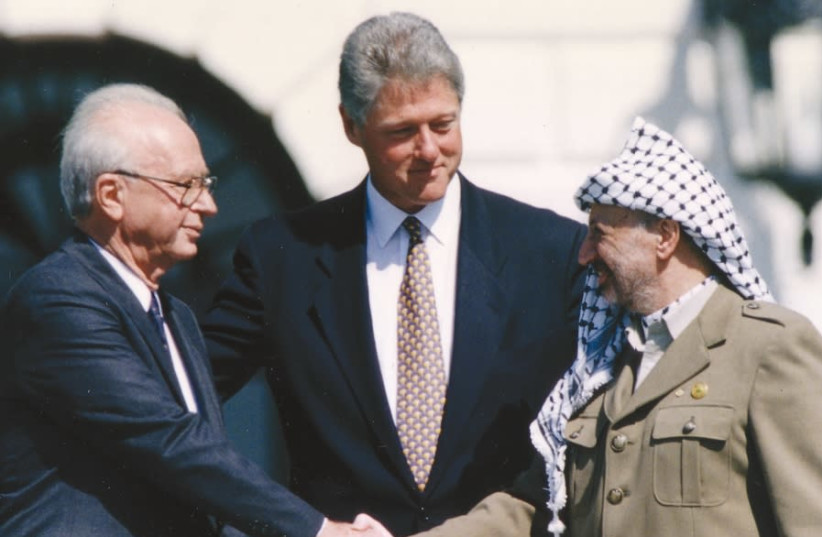The term “Oslo process” has become commonplace over the past three decades. Later this year, it will acquire even greater significance, as on September 13 the world marks the 30th anniversary of the signing of the first Oslo Accord.
The process itself, finalized in the second Oslo Accord in 1995, never came to fruition, but the basic rules that currently govern the inchoate Israeli-Palestinian situation stem from it. Yet until now, the public record has lacked a full explanation of how this key development in the long Israel-Palestinian saga came to be initiated and bear the name of the capital of a remote Scandinavian country.
In his new book Nir Levitan, a research fellow at Bar-Ilan University’s Europa Institute, subjects this issue to detailed, scholarly and fascinating scrutiny. Uncovering new material from national archives and from personal interviews with key negotiators, Levitan reveals that Norway was not alone in its involvement with the peacemaking process. He shows that two other Scandinavian countries – Sweden and Denmark– were also each, and separately, deeply engaged over many years in developing their own back channels with Israel and the Palestinians.
How the other Scandinavian countries tried to negotiate peace between Israel and the Palestinians
Based on his research, Levitan describes how the different peace-oriented policies of the three Scandinavian countries were fostered by them separately, and analyses the strengths and weaknesses of their different mediation strategies. His careful review of sources reveals how the Scandinavian countries, each with little political clout internationally, used diplomacy – their “soft power” – to muster the help of governments and agencies with greater weight on the international scene. He exposes the covert competition among the various Scandinavian negotiators for who was the most successful mediator.
Even more revealing is the evidence Levitan unearths showing how they used the Middle East peace process to strengthen their own national interests, financial standing and international status.

The astonishing end result, of course, was that collectively these efforts brought to the negotiating table the Palestinians under hard line Yasser Arafat, and the Israelis represented among others by Yitzhak Rabin and Shimon Peres.
A particularly interesting section of Levitan’s work deals with the truly persistent efforts of Sweden to position itself as a credible mediator in Palestinian eyes. Contacts established during 1987 and 1988, and assiduously fostered, served Sweden in good stead when, around the time of the first Oslo Accord, the parties agreed to establish a second secret and unofficial negotiating channel.
Although this initiative failed to take off, Sweden, undeterred, persisted in its efforts to broker negotiations in the Middle East. Their third and final attempt to resolve the Israeli-Palestinian conflict – the Harpsund negotiations – ended with the inconclusive Camp David Summit in 2000, followed almost immediately by the Second Intifada. The subsequent four and a half years of Palestinian violence and terror put to rest any peace-making hopes Sweden might have had.
Turning to Denmark, Levitan demonstrates that in its own way, it was equally determined to gain international recognition by intervening in the Israel-Palestinian dispute. It missed an early trick, though. Levitan reveals how the Danish Foreign Ministry refused to cooperate in a first attempt by historian Ron Pundak in 1992, and then later by his father, Herbert Pundak, to position Denmark as the lead nation in initiating a peace process. As a result, Ron Pundak turned to the Norwegians and represented Israel in secret Israel-Palestinian talks initiated by them.
FOLLOWING THE signing of the second Oslo Accord in 1995, however, the Danes offered the international community a vision of peace, not merely between Israel and the Palestinians but across the whole Middle East.
Their first unofficial attempt to mediate between the parties was aimed at increasing public support for this wider Arab-Israeli peace prospect. Their second was an official effort, supported by the Middle East Quartet (set up in 2002 and consisting of the UN, EU, US and Russia), to formulate the basis of a permanent agreement between Israel and the Palestinians. Known as the Roadmap for Peace, it proved of little consequence in influencing subsequent events.
In the final analysis, of course, Levitan’s story is one of failure. The efforts of all three Scandinavian nations failed to produce a final status deal between the Palestinians and Israel. The Oslo process, set out in the two accords signed by both parties, appeared to come the closest perhaps. It left a legacy of Palestinian Authority security forces under Mahmoud Abbas, frequently working with Israeli security forces, as well as moving Israel out of having to administer areas which were wholly populated by Palestinians.
But Levitan could give a little more consideration to the so-far insurmountable obstacle lying in the path of any peace initiative, namely the declared objective of the Palestinian leadership under Arafat, and subsequently, to say nothing of Hamas, of gaining the whole of Mandate Palestine “from the river to the sea” by removing the State of Israel from the Middle East.
Since that remains the “Palestinian cause” of Hamas and even various West Bank Palestinian terror groups, all well-meaning peace efforts, including those of the Scandinavian nations, had a steep uphill battle to contend with. What Levitan does reveal, however, are the subsidiary, but important, national benefits that the Scandinavians sought, and in some measure gained, by their efforts in this field.
Scandinavian Diplomacy and the Israeli-Palestinian Conflict, a deeply researched and scholarly work, throws new light on an under-explored byproduct of the long Israel-Palestinian saga. It makes fascinating and rewarding reading for academics and the public alike. ■
Scandinavian Diplomacy and the Israeli-Palestinian Conflict
By Nir Levitan
Routledge
226 pages; $160
